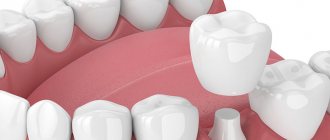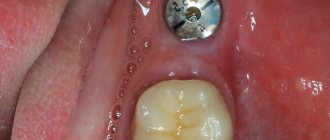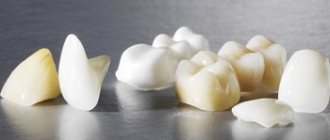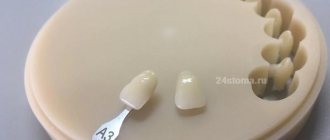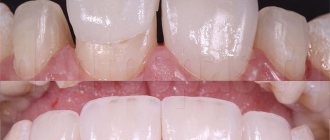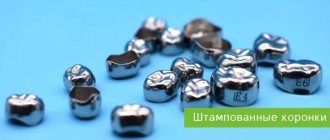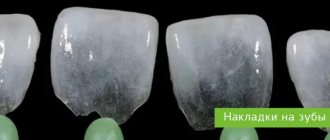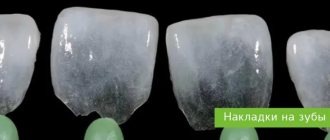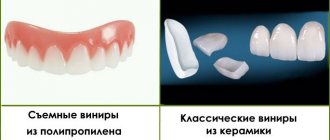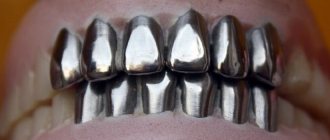- Indications
- Materials
- Manufacturing methods
- Stages of treatment
- Life time
- Care
- Prices
- Doctors
- Reviews
Provisional or temporary crowns are installed while preparing for permanent prosthetics. They protect sharpened teeth from the aggressive environment of the oral cavity, restore chewing function, the aesthetics of a smile, provide comfort during communication, and prevent gum growth until a permanent orthopedic structure is installed. The prosthesis is made from high-quality, non-toxic materials. Despite the fact that these are temporary orthopedic structures, their functional significance is very high. The cost of a temporary crown per tooth depends on the material, type of product, and manufacturing method.
- When to use:
Severely damaged tooth (temporarily) - Treatment period:
1 visit - Type of anesthesia:
Local - Healing period:
no - Procedure time:
5-15 minutes - Age restrictions:
From 18 years old
Why are provisional crowns needed?
- Prevention of changes in bite – eliminates the displacement of teeth in a row;
- protection from infections, thermal, chemical irritants to the tissue of prepared units;
- preventing gum growth around the stump;
- maintaining normal diction and correct pronunciation;
- restoration of chewing function;
- formation of an aesthetic gingival margin;
- prevention of mechanical damage to teeth and gums;
- adaptation to the volume and shape of the future permanent orthopedic system.
A temporary dental crown is installed on your own tooth, as well as on an implant, immediately after its implantation into the bone tissue using a one-stage protocol or 10-14 days before installing a permanent orthopedic structure using classical technology.
Basic functions of crowns
It would be wrong to consider restoration of aesthetics to be the main function of using such an orthopedic design. A crown really fills a gap in the dentition, but there are several additional tasks:
- Preservation of the socket in the gum. This is necessary in order to reduce the complexity and trauma of surgical intervention during the process.
- Keeping teeth in place. When a person is missing one of the teeth, there is a possibility that the neighboring teeth will begin to shift and more gaps and crevices will appear in the row. When a temporary crown is placed, this phenomenon is not observed.
- Elimination of pain. This is especially true if the prosthetic procedure does not require removal of the nerve. In this case, while the permanent crown is being created, the temporary one will eliminate the likelihood of strong pressure and discomfort.
Since the prosthetic technology itself involves slight grinding of the enamel of adjacent teeth, it is important to provide them with additional protection. And temporary crowns do an excellent job with this task. The development of hypersensitivity, as well as the risk of caries, is excluded.
Materials
Various plastics (acrylic, polymethyl methacrylate PMMA) and composites are used for manufacturing. The materials reproduce different colors and shades, are quite durable, and can withstand moderate chewing load. For complex rehabilitation of multiple dental defects, metal-composite or metal-plastic structures on implants are used. Such prostheses consist of a lightweight metal frame lined with composite or plastic. The crown is secured with cement. It holds it firmly, but at the same time, the prosthesis can be easily removed for treatment and installed again.
Alekperov Roman Borisovich Dentist-orthopedist, doctor of the highest category
I got a temporary lab crown two months ago. It's time to do a re-prosthesis, but it hasn't broken and I'm satisfied with its appearance. How much longer can I walk with a prosthesis?
This question will be better answered by an orthopedist after examining the situation. The prosthesis has a service life that should not be exceeded.
Alekperov Roman Borisovich Dentist-orthopedist, doctor of the highest category
I got a temporary crown three months ago. Yesterday a corner broke off from it. How urgently do I need to come to the clinic for re-prosthetics?
A three-month period is the standard period for wearing a temporary prosthesis, which should not be much exceeded. If the corner of the crown is broken, the sharp edge can injure the mucous membrane and cause inflammation. If possible, you should come to our clinic as quickly as possible; if this is not possible, you should contact orthopedists at your place of residence so that they can polish the chip.
How long does the service life last?
How long can you wear temporary crowns? Most patients go with them for a fairly short period of time - about 2 weeks. If more time is required to manufacture the prosthesis, the service life can be increased to 1 month. Dentists do not recommend wearing plastic “caps” for longer, because... they quickly become unusable, and as a result, the supporting tooth “suffers.” But composite ones can be worn for a longer period - up to several months, but not more than 1 year. Temporary dentures on implants are usually worn until the implant itself has taken root - up to 6 months. Here they have a slightly different fixation system, which is why the wearing period increases.
“I wanted to whiten my teeth before my wedding, but I went too far with the exposure time of the whitening strips and ended up with serious problems. The dentist said that I need to get crowns because with my fillings it is useless to build them up. And “Day X” is getting closer... I had to install temporary composite ones for now, they said that I could do this for 3-4 months. And the doctor chose the color very well, the smile in the photos is simply gorgeous!”
Anastasia, review from forum.stom.ru
Manufacturing methods
Provisional structures are made by direct and indirect methods.
- Direct
is an express technique that allows you to make a crown from plastic or composite in a matter of minutes
in the dentist’s chair
. The doctor takes an impression of the patient’s jaw using silicone paste, prepares the stump (grinds the tooth, giving it the desired shape). Fills a silicone impression with plastic material and places it on the tooth. After the material has hardened, an impression is taken, the prosthesis is given the desired shape according to the bite, firmly fixed with dental cement, ground, and polished. - Indirect
– a temporary plastic crown for a tooth is made in a dental laboratory, based on an impression of the patient’s jaw. The technique allows you to take into account the characteristics of jaw closure and the structure of the dentition. jaw movements. The prosthesis can be made in the laboratory in two ways - by a dental technician using the classical method or using CAD/CAM technology.
The direct method is economical, fast, but does not provide good aesthetics. Making a crown using the indirect method takes 1-2 days. The dentures fit exactly and are identical to natural teeth in shape and shade. Provisional structures made of thermoplastic material PMMA are reliable, durable, and suitable for patients with allergies to plastics.
Question No. 7: what are the consequences of untimely crown replacement?
The outer layer of the temporary structure is short-lived. Over time it wears off. If the provisional restoration is not replaced within the time frame recommended by doctors, the material may become damaged and uneven edges will appear on it, which injure the mucous membrane and antagonist teeth located on the opposite jaw. If the plastic loses its integrity and homogeneity, then bacteria and pieces of food will clog into the smallest cracks of the prosthesis, provoking an inflammatory process in the oral cavity.
In addition, with prolonged use, artificial dentures will begin to wear down, which will negatively affect the bite and normal functionality of the maxillofacial apparatus. Because of this, problems with chewing food, headaches, and gastrointestinal diseases may begin.
Temporary prosthetics of anterior teeth
Prosthetics with a temporary crown of incisors or fangs involves preserving the aesthetics of the smile. Prostheses are made in a laboratory (indirect) method. Select a shade of material similar to the color of the natural enamel of neighboring units. Installing a temporary crown on the front tooth allows you to make the intermediate stage of prosthetics more comfortable.
Plastic imitates enamel well and can withstand moderate chewing load. The procedure for installing provisional structures on the anterior or chewing units is no different. The only difference is that plastic structures on molars and premolars wear out and crack very quickly. If you plan to wear a provisional system for longer than 3-4 weeks, it is recommended to order lightweight metal-plastic or metal-composite prostheses.
Why do you need a “temporary” solution?
Life experience suggests that when we are offered incomprehensible solutions or there are doubts about their appropriateness, the fragile, not yet fully formed trust in a specialist, and in our case in a doctor, can be destroyed.
The fact that, in principle, without teeth is bad is clear, therefore it is advisable to restore them and, if possible, not to postpone prosthetics for a long time.
However, why make “temporary” crowns or even more complex “temporary” orthopedic structures, because they cost money, and wearing them delays the completion of treatment?
Maybe it would be better to immediately manufacture and install the desired denture?
Now we will try to explain the importance of the temporary prosthetics stage and tell you how it affects the course of treatment and the final result.
Stages of installing temporary crowns
- Tooth preparation
– the doctor gives the stump the desired shape (depulps, fills canals, strengthens with a stump inlay, grinds) - Taking impressions
– using an impression tray and plastic material, an impression is taken from the patient’s jaw - Making a crown
- the prosthesis is made directly (in the dentist's chair) or indirectly (in the laboratory) - Installation
- fixation of the temporary crown is performed with dental cement.
Contact our clinic for installation
Our clinic installs permanent crowns from different types of materials. In favor of contacting us he says:
- Affordable cost of services.
- High speed.
- High-quality materials for temporary crowns.
- Experienced doctors and professional equipment.
- Promotions and special discounts.
- Free first doctor's appointment and x-ray.
Our clinic is located in Khimki. Also, clients often come to us from neighboring cities - Kurkino, Novogorsk and others.
To make an appointment for your first consultation, leave a request on the website or call us.
Care
- Brush your teeth thoroughly twice a day, without putting excessive pressure on the denture;
- limit the chewing load in the area of prosthetics;
- eliminate hard, sticky foods;
- limit foods and drinks that can stain the prosthesis material (coffee, tea, red wine, etc.);
- do not wear the device for longer than the period recommended by the dentist;
- If the prosthesis is displaced or damaged, immediately contact the dentist.
Article Expert
Alekperov Roman Borisovich Dentist-orthopedist, doctor of the highest category
Work experience: more than 32 years
Purpose
A tooth ground down for a crown becomes unattractive. What remains of it is a “stump”. What if it's a front incisor? The person will experience a feeling of embarrassment, discomfort, and will begin to constantly cover his mouth with his hand. Temporary (provisional) crowns solve this problem by visually restoring integrity during the period of production of the permanent one.
In addition to the aesthetic function, they solve problems such as:
- dulls the sensitivity of dental tissue to cold, hot and other irritants;
- prevent gum swelling;
- securely fix the tooth, preventing its displacement and loosening;
- maintain diction;
- temporarily restore tooth function.
The products are designed for a short period of operation, therefore they are made of porous material. For this reason, a temporary structure cannot be used as a permanent one. If you do not follow the rules of oral hygiene, over time, pathogenic microflora will penetrate through the pores of the provisional product to the ground tooth and cause its inflammation.
When drinking wine, coffee, tea, as well as smoking, the plastic can change its color, so before installing a standard one, it is better to avoid using coloring products.
Sometimes temporary structures are installed due to lack of money for a regular crown. This is allowed, but you still need to remember that the temporary product is designed for a short period of use, so there is no need to postpone your next visit to the doctor for too long. The permanent one will serve for many years and reliably protect the tooth underneath from negative influences.
Question No. 9: what to do if the crown falls out?
Considering that the provisional prosthesis is fixed with temporary, that is, non-permanent cement, this situation is possible. If this happens, then nothing can or should be done at home. It is necessary to consult a doctor as soon as possible, who will clean the structure and fix it again.
If a crown falls out, you should consult a specialist.
Remember, in some cases the crown falls out not due to depressurization of the cement or the use of low-quality glue, but due to chipping and destruction of hard tissues and the development of an inflammatory process.
Not only the crown, but also the filling can fall out! What to do in such a situation? Read the article on the website: “A filling fell out - answers to the most popular questions about the problem.”
Comments
I have a very decayed tooth in my mouth. There has been a huge filling on it for several years now. The last time I visited the clinic, the doctor recommended replacing the filling with a crown, at least temporarily. I don’t know whether to leave everything as it is or change it?
Dmitry (09.27.2020 at 20:03) Reply to comment
- If a little more than half of the tooth remains, then wearing a large filling is not advisable, because it can very unexpectedly collapse and chip along with the walls of the tooth. Or it can crack, and then the tooth can literally fall apart piece by piece. If this happens, then you will have to restore the tooth at great expense, for example, installing not only a crown, but also strengthening the root with a pin or stump insert. You need to decide on prosthetics faster. Alternatively, while you are choosing the material for a permanent crown, you can install a temporary one.
Editorial staff of the portal UltraSmile.ru (02.10.2020 at 09:15) Reply to comment
Write your comment Cancel reply
Stock
-47%
Dental implant Osstem 35,000 rub.
18500 rub.
get -9 %
BASAL COMPLEX - Restoration of teeth on 1 jaw in 3 days 330,000 rub.
300,000 rub.
get -27 %
Teeth in 1 day on Straumann implants using ProArch technology!
300,000 rub. 220,000 rub.
get -13 %
Promotion for installation of veneers!
40000 rub. 35,000 rub. get
What are they and why are they needed?
When a tooth is destroyed by more than 60%, there is no way to do without prosthetics. This can happen if he:
- was affected by caries;
- broken;
- worn out.
Of course, you can try to fill the tooth, “finishing” it to its original shape, but the filling cannot withstand the loads that the teeth are subjected to when chewing food, and very soon it will simply crumble, and the remaining thin walls of the tooth may chip.
But creating a permanent prosthesis is not a quick task. Therefore, while it is being manufactured, a temporary one can be inserted in place of the missing tooth, which the patient will use at all stages of orthopedic treatment.
